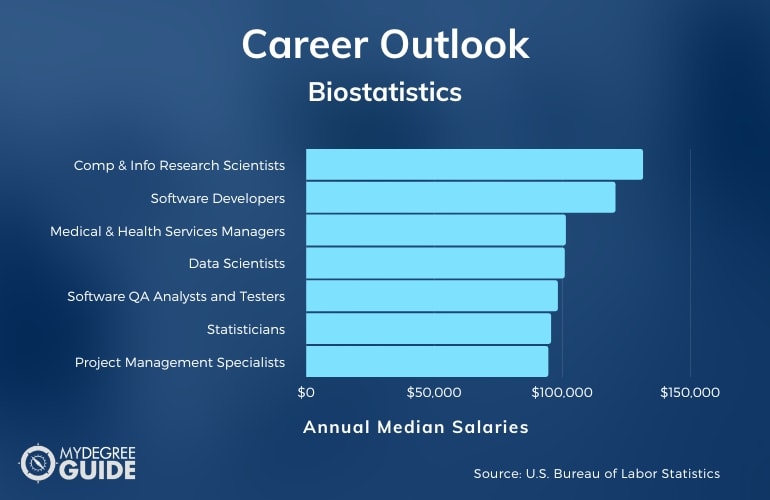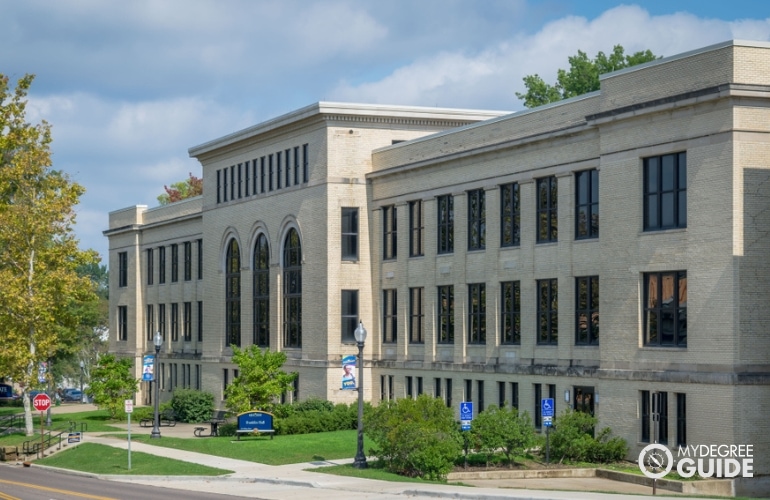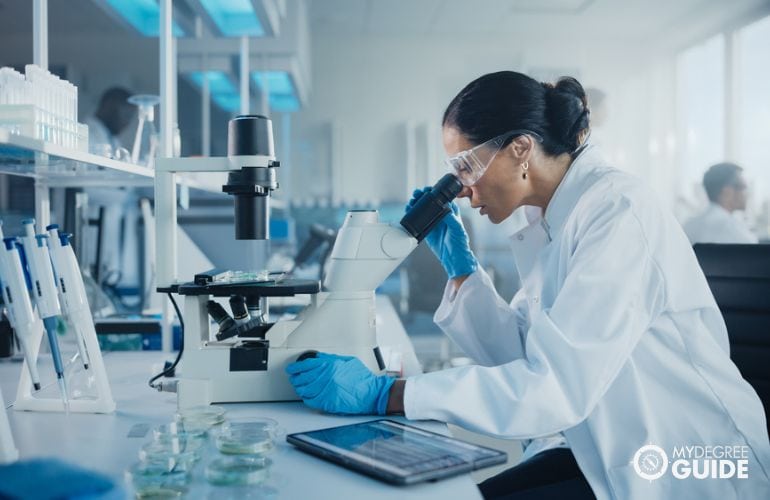An online masters in biostatistics can offer students the opportunity to combine their interests in public health and mathematics.

Biostatistics is a strategic field to pursue if you are seeking a career with an above average salary, job security, and the potential to make a significant difference in people’s lives. If you have completed a bachelor’s degree and love data—or if you are currently employed as a statistician and want to advance your career—earning an MS in Biostatistics online might be a great fit.
Editorial Listing ShortCode:
Read on to learn more about the requirements and opportunities involved in biostatistics.
Universities Offering Online Masters in Biostatistics Degree Programs
Methodology: The following school list is in alphabetical order. To be included, a college or university must be regionally accredited and offer degree programs online or in a hybrid format.
1. City University of New York
City University of New York offers an MPH in Epidemiology and Biostatistics. Along with their coursework, students in the program must participate in supervised fieldwork and complete a capstone project. The curriculum consists of courses such as Public Health Leadership and Management and Designing and Evaluating Public Health Interventions.
CUNY is accredited by the Middle States Commission on Higher Education.
2. Claremont Graduate University
Claremont Graduate University offers an MS in Applied Biostatistics. The program requires the completion of 38 units of coursework—30 units of core courses and 8 units of electives. To receive practical training, students must also complete 200 hours of internship or research with faculty.
Claremont Graduate University is accredited by the WASC Senior College and University Commission.
3. Columbia University
Columbia University’s online MS in Epidemiology program is designed for working professionals. The curriculum consists of courses such as Introduction to Biostatistics, Analysis of Categorical Data, and Applied Regression. Many courses are asynchronous and feature recorded lectures to help accommodate busy schedules. Any synchronous class meetings that are required are held during the weekend.
Columbia University is accredited by the Middle States Commission on Higher Education.
4. East Tennessee State University
East Tennessee State University’s MPH in Biostatistics can be completed fully online or on campus. The program requires 43 to 46 credits of courses such as Community-Based Methods in Public Health, Categorical Data Analysis, and Health Leadership and Management. GRE scores are not needed to apply, and prospective students can apply to begin in fall or spring semesters.
East Tennessee State University is accredited by the Southern Association of Colleges and Schools Commission on Colleges.
5. George Washington University
George Washington University offers a Master of Public Health in Biostatistics. The program requires the completion of 45 credits. Up to 15 credits may be taken online. Students are also required to participate in an applied practical experience in a real-world setting. The curriculum consists of courses such as Fundamentals of Program Evaluation, Principles and Practice of Epidemiology, and Principles of Clinical Trials.
George Washington University is accredited by the Higher Learning Commission.
6. Johns Hopkins University
Johns Hopkins University offers a Master of Public Health with a concentration in Epidemiologic and Biostatistical Methods for Public Health and Clinical Research. The program is available both online and onsite and is intended for students with at least two years of relevant work experience.
Johns Hopkins University is accredited by the Middle States Commission on Higher Education.
7. Kent State University
Kent State University offers a Master of Science in Clinical Epidemiology that can be completed 100% online. The program requires the completion of 36 credits and can potentially be finished in 2 years. Each course is 15 weeks long, and students typically take two at a time. Students can choose between completing a thesis or a research practicum.
Kent State University is accredited by the Higher Learning Commission.
8. North Carolina State University
North Carolina State University offers a Master of Statistics with a concentration in Biostatistics. This in-person program can potentially be completed in just 1 year of full-time study. The curriculum consists of courses such as Statistical Theory, Linear Models, Clinical Trials and Epidemiology, and Applied Multivariate and Longitudinal Data Analysis.
North Carolina State University is accredited by the Southern Association of Colleges and Schools Commission on Colleges.
9. Pennsylvania State University
Pennsylvania State University’s online Master of Applied Statistics program emphasizes hands-on learning and use of the latest software. It requires the completion of 30 credits of courses such as Introduction to Probability Theory, Epidemiologic Research Methods, Design and Analysis of Clinical Trials, and more. The courses are highly interactive and provide opportunities to network with other professionals.
Pennsylvania State University is accredited by the Middle States Commission on Higher Education.
10. Purdue University
Purdue University offers a Master of Public Health that can be earned online. Most classes are asynchronous but include discussion boards so that students can interact with their classmates. To gain real-world experiences, students must also complete 200 hours in a practicum. Applicants do not need any prior background in public health.
Purdue University is accredited by the Higher Learning Commission.
11. Temple University
Temple University offers an MPH in Epidemiology program that is designed to prepare students for practice-oriented and research-oriented careers. The student-to-faculty ratio in the program is just 5-to-1, and the program’s instructors have practical experience in a wide range of settings. Students can study full-time on campus or part-time on campus or online.
Temple University is accredited by the Middle States Commission on Higher Education.
12. Tufts University
Tufts University offers an online program for an MPH with a concentration in Epidemiology and Biostatistics. The curriculum consists of courses such as Principles of Epidemiology, Healthcare Organization: Budgeting and Management, and Principles of Biostatistics.
Students must also participate in a 160-hour practicum to gain real-world experience. GRE scores are not required to apply. Many students are able to graduate from the program in just 20 months.
Tufts University is accredited by the New England Commission of Higher Education.
13. University of California – Berkeley
The University of California—Berkeley offers an MPH with a specialization in Epidemiology and Biostatistics. The program is mostly online but does require on-campus summer sessions where students have opportunities to meet teachers and classmates in person. It is intended for mid-career professionals and usually takes 27 months to finish.
The University of California – Berkeley is accredited by the Western Association of Schools and Colleges.
14. University of Florida
The University of Florida offers an online program for a Master of Science in Biostatistics. Students may choose a concentration in Biostatistics Methods and Practice or Health Data Science. The program requires the completion of 36 credit hours and culminates with a capstone experience during the final semester.
The University of Florida is accredited by the Southern Association of Colleges and Schools Commission on Colleges.
15. University of Louisville
The University of Louisville offers a fully online program for a Master of Science in Biostatistics. The curriculum is built to provide experience in using statistical software programs, such as R, SAS, and SPSS. The degree requires the completion of 33 credit hours and can potentially be completed in just 3 semesters. The program boasts a 100% employment rate for its graduates.
The University of Louisville is accredited by the Southern Association of Colleges and Schools Commission on Colleges.
16. University of Nebraska
The University of Nebraska offers an online program for a Master of Public Health with a concentration in Biostatistics. It requires the completion of 42 credits of courses such as Biostatistics I, Design of Medical Health Studies, and Categorical Data Analysis. Prospective students can apply to begin in the fall, spring, or summer.
The University of Nebraska is accredited by the Higher Learning Commission.
17. University of Nevada – Reno
The University of Nevada—Reno offers an online program for a Master of Public Health in Public Health Practice that can potentially be completed in just 2 years. There are no residency requirements, and multiple start dates are offered each year. The program does require the completion of 200 hours of field experience in a public health setting.
The University of Nevada – Reno is accredited by the Northwest Commission on Colleges and Universities.
18. University of South Dakota
The University of South Dakota’s Master of Public Health can be completed 100% online. The program requires the completion of 42 credit hours of courses like Biostatistics for Public Health, Public Health Theory and Practice, and Epidemiology. The program also offers students the opportunity to participate in an applied practice experience.
The University of South Dakota is accredited by the Higher Learning Commission.
19. University of Southern California
The University of Southern California offers a Master of Public Health with a concentration in Biostatistics and Epidemiology.
The curriculum consists of courses like Data Analysis (SAS), Data Analysis (STATA), Epidemiology of Infectious Disease, and Chronic Disease Epidemiology. The program is available online. USC’s online students must participate in live meetings and can receive personalized support from faculty.
USC is accredited by the Western Association of Schools and Colleges.
20. University of Tennessee Health Science Center
The University of Tennessee Health Science Center offers an MS in Epidemiology with a Biostatistics track. The program requires the completion of 36 credit hours, and all core courses are available online. Full-time students can typically finish in 2 years. Potential courses include Using R for Biostatistics I and II, Fundamentals of Epidemiology, and Genetic Epidemiology.
The University of Tennessee Health Science Center is accredited by the Southern Association of Colleges and Schools Commission on Colleges.
Masters in Biostatistics Programs Online

For students with both scientific and mathematical interests, biostatistics has a lot to offer. If you want to help improve public health outcomes but also enjoy studying and using data, completing a biostatistics masters program online could allow you to pursue both goals.
The goal of a biostatistics professional is to apply statistical methods to the study of biology, human health, and diseases. Some of the subjects that you are likely to study in biostatistics masters programs online include:
- Community health
- Genetics
- Data analysis
- Designing and managing clinical trials
- Statistical theory
- Public health
- Research methods
- Probability
- Epidemiology
- HIPAA compliance
- SAS programming
Many biostatistics students also choose to specialize in a certain area. For example, you might enroll in a program that incorporates aspects of biostatistics with bioinformatics or epidemiology. Alternatively, you may focus on the leadership and project management aspects of biostatistics.
Much like with an online degree in biology, after graduating with an online biostatistics degree, you may be well-prepared to work for many kinds of organizations in different areas of employment. Common employers include:
- The pharmaceutical industry
- The local, state, or federal government
- Academic institutions
- Healthcare facilities
These types of organizations look for biostatistics professionals who can help them conduct clinical trials and draw conclusions from data. Biostatistics professionals may also present information to the public and other members of the industry via papers and presentations.
Becoming a biostatistician is the most common career path for a biostatistics graduate, but they might also consider related positions. These include data scientists, operations research analysts, and more generalized statisticians. After earning a degree from your graduate program, you may also decide that you want to further advance your education and career.
An accredited master’s degree in biostatistics could help you qualify for acceptance to a related doctoral program.
Biostatistics Careers and Salaries

After earning a master’s degree in biostatistics, you may be well-qualified for positions with a variety of employers. Common employers include pharmaceutical companies, medical research facilities, and government agencies.
While earning their degrees, biostatistics students can develop a thorough understanding of data analysis, which is a vital skill in nearly every industry. As a result, these graduates often have a large pool of prospective employers to choose from.
According to data from the Bureau of Labor Statistics, these are some potential career paths for professionals with graduate-level training in biostatistics.
| Careers | Annual Median Salaries |
| Computer and Information Research Scientists | $131,490 |
| Software Developers | $120,730 |
| Medical and Health Services Managers | $101,340 |
| Data Scientists | $100,910 |
| Software Quality Assurance Analysts and Testers | $98,220 |
| Statisticians | $95,570 |
| Project Management Specialists | $94,500 |
| Computer Programmers | $93,000 |
| Operations Research Analysts | $82,360 |
| Postsecondary Teachers | $79,640 |
Professionals who work in biostatistics and similar fields often enjoy job security. The need for employees who are skilled in mathematics, analysis, and science places graduates of these programs in high demand.
According to the Bureau of Labor Statistics, statisticians are projected to see 33% job growth over the next ten years, which is much faster than average. Growth rates for related areas of employment, including operations research analysts (23%) and postsecondary teachers (12%), are also very promising.
The type of positions you can qualify for might depend on your degree specialization or previous experience and education.
Biostatistics Master’s Curriculum & Courses

The curriculum for a biostatistic master program generally includes core courses and a variety of electives. Some examples of common classes include:
- Probability: This class centers on probability theory and covers topics like probability distributions, moment generating functions, and limit theorems.
- Biostatistical Methods: In this course, you’ll explore statistical principles and methods like exploratory data analysis, graphical methods, and hypothesis testing.
- Clinical Trials: In this class, you’ll discuss the design and planning of clinical trials and relevant ethical issues.
- Public Health: In this class, you’ll learn about the role of biostatistics in public health.
- Mathematical Statistics: This course focuses on the foundations of statistical theory, including sufficiency and completeness, confidence intervals, and likelihood ratio tests.
- Categorical Data Analysis: In this course, you’ll learn about data analysis models and methods that are applicable to biomedical and public health research.
- Survival Analysis: This class centers on the analysis of survival data, including log-rank tests and goodness-of-fit tests.
- Statistical Computing: This course involves the study of the SAS system and how it can be used to structure, format, and manipulate data.
- Writing and Presentation Skills for Biostatistics: In this course, you’ll learn how to communicate and collaborate as a member of a research team.
- Biomedical Data Science: This class covers the use of statistics in biomedical data, with a focus on extracting and analyzing data related to public health, biology, and medicine.
Students who have chosen to specialize in a particular area of biostatistics may take other courses related to topics like machine learning or epidemiology. Most online biostatistics master’s programs conclude with a thesis or capstone project.
Admissions Requirements

It’s necessary to have completed a bachelor’s degree before enrolling in a biostatistics master’s degree program. Other admissions requirements may include:
- Statement of purpose. You can explain your interests, goals, and reason for applying to the program.
- Transcripts. You’ll submit official documentation from your undergraduate studies.
- Letters of recommendation. You may request letters from former supervisors and instructors who can speak to your strengths.
- Test scores. Some schools require scores from the GRE, while others do not.
- Official application. Following the instructions closely can help ensure you don’t leave out any details.
You may also be required to pay a fee when submitting your application and materials.
Online Biostatistics Masters Accreditation

In addition to evaluating the curriculum and cost of an online program, it’s also important to verify whether it’s accredited.
Academic institutions that are accredited have undergone thorough quality assessments. Regional accreditation is the most widely recognized status because the standards set by regional accreditors are extremely high, which helps ensure that you’ll receive a high-quality education.
It’s also typically easier to transfer credits from a regionally accredited school. This could be helpful if you ever need to change colleges or choose to pursue a doctoral degree. Plus, employers tend to look more favorably at a degree that was awarded by a regionally accredited school.
Financial Aid and Scholarships

The first step for most students who are planning to attend graduate school is to file a FAFSA. Completing this form is necessary to determine whether you are eligible for federal financial aid. There may also be a separate form available to apply for state aid.
If you are currently working for an employer in the medical field, it’s possible that you have access to a tuition assistance or reimbursement program. You can inquire with your supervisor or the human resources department to determine whether such a program exists at your work.
Finally, scholarships are one of the most sought after forms of aid for many students. You can research scholarship programs that are available through your school of choice or through groups like industry organizations.
What Is Biostatistics?

Biostatistics is a branch of statistics that involves collecting, analyzing, and interpreting data related to living organisms. Students in biostatistics programs learn the skills necessary to answer vital questions in the areas of medicine, public health, and biology.
Professionals in biostatistics have a combination of knowledge in science, mathematics, and statistics. Possible issues that biostatisticians address include the causes of particular diseases, survival rates for illnesses, and whether a newly developed drug is effective. Biostatistics experts help design studies and trials, conduct research, and collaborate with other scientists to address these pressing issues.
Is Biostatistics Hard?
The question of whether you will find biostatistics difficult depends on your interests and skills. Some of the most important subjects for biostatistics programs include:
- Advanced mathematics, like calculus
- Statistics
- Applied sciences
- Computer science
It may help to have a strong undergraduate background in these areas. To promote the success of their students, some graduate schools require you to complete certain mathematics courses before enrolling. Students who enjoy analyzing data, working with numbers, and addressing complex research questions may find a biostatistics program enjoyable even if it’s challenging.
What Can You Do with a Master’s in Biostatistics?

A master’s degree in biostatistics may help open doors to new career opportunities involving the process of gathering, analyzing, and presenting data. Potential employers include universities, medical research labs, and private businesses.
Some of the jobs that are well suited to graduates of biostatistics programs include biostatisticians, research analysts, data scientists, and postsecondary teachers. According to the Bureau of Labor Statistics, these positions tend to pay above-average salaries.
Many biostatistics professionals work in laboratories or office settings. Others work as consultants and travel between work sites within the country or even around the world. Yet others may opt to continue their educations and apply to a PhD in Biology online or on-campus program.
What Do Biostatisticians Do?
The primary goal of a biostatistician is to gather and interpret data so that they can answer questions related to people’s health.
For instance, they might try to determine how certain characteristics alter the effectiveness of a medical treatment. To draw these conclusions, biostatisticians collect data from databases, surveys, studies, and trials. They collaborate with subject matter experts, help design studies, and use statistical models and methods to analyze the results.
Biostatisticians are also responsible for communicating what they learn through presentations and reports. They may also make recommendations for changes or improvements to existing or planned systems or procedures.
Is Biostatistics a Good Career?

Yes, biostatistics is a good career for many professionals. People in this field can make direct contributions to the health and wellbeing of the public by helping with important medical developments.
According to the Bureau of Labor Statistics, a career in biostatistics can be not only emotionally but also financially rewarding. For instance, statisticians have a median salary of $95,570, which is much higher than average. Biostatistics is also very stable in terms of job growth. The Bureau of Labor Statistics projects that the growth rate for statisticians over the next ten years will be around 33%, which is much faster than average.
Where Do Biostatisticians Work?
Depending on your location and level of experience, a degree in biostatistics may help you qualify for a position with a range of employers. Pharmaceutical companies, the insurance industry, and universities all seek out biostatisticians.
Potential employers in the field of healthcare include medical laboratories, hospital systems, and health research facilities. Many nonprofits and private businesses also hire biostatisticians to conduct research and data analysis. Within the government, agencies such as the Food and Drug Administration, Census Bureau, and National Institute of Health employ biostatisticians to lead trials and carry out essential studies.
How Much Do Biostatisticians Make?

Most biostatisticians earn salaries that are higher than average. Data from the Bureau of Labor Statistics shows that statisticians as a whole earn a median salary of $95,570.
Most make between $49,350 and $157,300 each year. Potential earnings could differ significantly depending on your prospective industry and employer. For instance, statisticians working for a college, university, or professional school earn a median salary of $77,750.
In comparison, $114,770 is the median wage for statisticians who work in research and development in the physical, engineering, and life sciences. Statisticians working for insurance carriers and related activities earn a median salary of $83,820.
How Long Does It Take to Get an Online Masters in Biostatistics?

The lengths of biostatistics programs differ based on factors like your enrollment status, the number of required credits, and final project requirements. Many programs, like an online masters in biomedical informatics, include between 32 and 42 credit hours, which full-time students can generally complete in 1 year to 2 years.
If you are attending part-time, or if the program has a thesis requirement, the completion time may be longer. Biostatistics graduate degrees that culminate in a capstone project often take less time than those with thesis components.
In contrast, some schools offer condensed or accelerated programs that can be completed in as little as 1 year. These are sometimes offered in combination with a bachelor’s degree program.
What’s the Difference Between a Master’s Degree in Biostatistics vs. Bioinformatics?
Although biostatistics and bioinformatics are similar and often have overlapping career paths, there are some important differences between these master’s programs.
| Master’s in Biostatistics | Master’s in Bioinformatics |
|
|
Both biostatistics and bioinformatics graduates may find themselves working for public health institutions, research programs, and pharmaceutical companies.
What’s the Difference Between a Masters in Biostatistics vs. Statistics?
Both statistics and biostatistics involve the collection, interpretation, and presentation of data.
| Masters in Biostatistics | Masters in Statistics |
|
|
The choice between statistics and biostatistics ultimately comes down to whether you are more interested in the broad applications of data analysis or its specific uses in healthcare.
What’s the Difference Between Epidemiology vs. Biostatistics Online Masters Degree?
The study of epidemiology includes many of the models and methods used in biostatistics, but these fields are still distinct.
| Masters in Biostatistics | Masters in Epidemiology |
|
|
Epidemiologists also tend to be more involved in community outreach and education than biostatisticians.
Is a Masters in Biostatistics Online Degree Worth It?

Yes, a masters in biostatistics online degree is worth it for many professionals. Biostatistics serves as preparation for a variety of promising careers.
Biostatistics careers also offer a high level of stability. For society to continue to thrive, it’s vital that experts understand the development and effects of medical treatments and diseases. As a result, these professionals are likely to remain in high demand for the foreseeable future.
According to the Bureau of Labor Statistics, the projected growth rates for statisticians (33%), operations research analysts (23%), and software quality assurance analysts and testers (21%) are much faster than the average for all occupations.
Getting Your Biostatistics Masters Online

If you love solving problems, excel at crunching numbers, and have a passion for the medical field, biostatistics may be a strategic focus for your education.
Accredited online masters in biostatistics programs can help you build a solid foundation for a career as a biostatistician. Biostatisticians play an integral role in the continuing growth and development of innovative healthcare solutions. Earning your master’s degree in biostatistics is a strategic step toward becoming a part of this rising field.
To get started, you can search for accredited schools with biostatistics programs and specializations that align with your interests.
